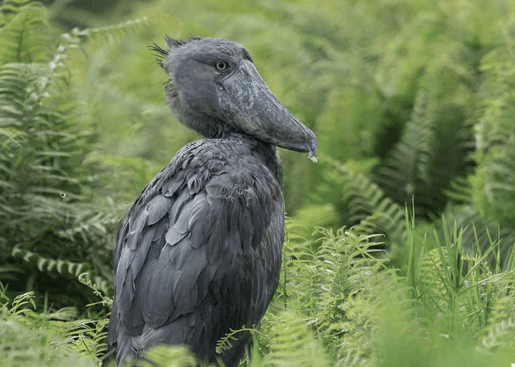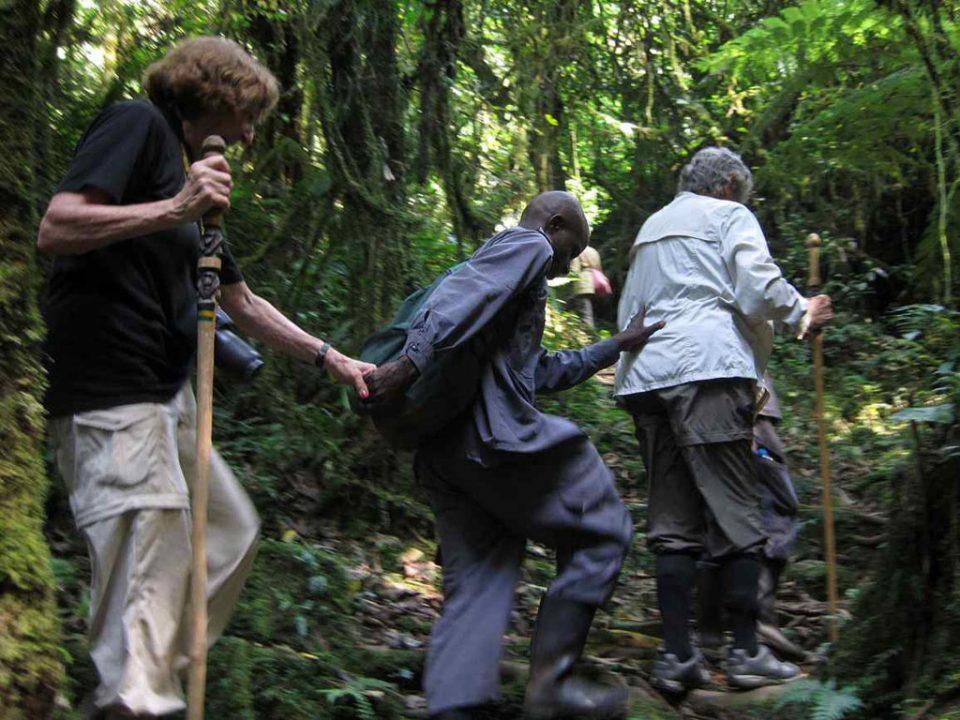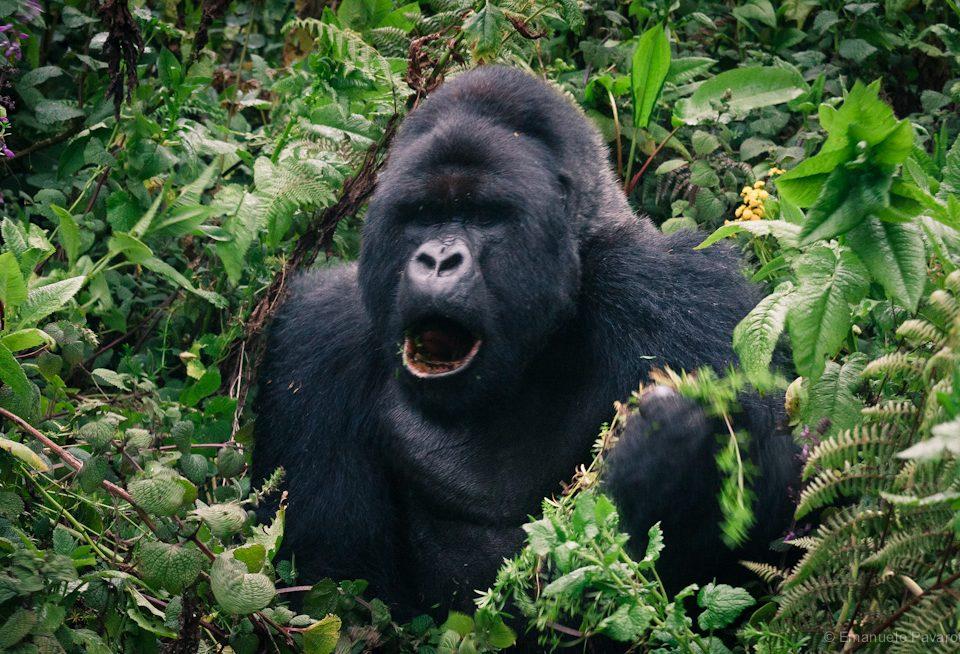
The Shoebill (aka Whale-head, aka shoe-billed Stork, aka Balaeniceps rex) is a large wading waterbird. That stalks the marshes of tropical East Africa in South Sudan and Uganda. It stalks along the swampy Nile River and Lake Victoria shores, snatching up prey with its unique, immediately recognizable bills. The shoebill is one of the five most desirable birds in Africa by birdwatchers.
The best place to view the shoebill is in the vast wetlands of the Nile in Uganda. They are found around the Mabamba Bay marshes on Lake Victoria shores in Entebbe.
You really can’t mistaken the shoebill for any other bird. They grow 4 to 5 feet tall, have bluish-gray plumage, and an 8-plus-foot wingspan. Their bill, which takes up most of their face, looks like a huge Dutch wooden clog.
Classification: Heron, Stork or Pelican?
According to Wikipedia, the shoebill is known to both ancient Egyptians and Arabs but was not classified until the 19th century. After skins and eventually live specimens were brought to Europe. John Gould, an English ornithologist, described it in 1850, giving it the name Balaeniceps rex. Or, ‘Whale-head’ from the Latin words Balaena “whale” and caput “head,” abbreviated to -ceps in compound words.
Traditionally classified with storks (Ciconiiformes) and retained there, but recently taxonomists have awakened the debate. They are now classified as the grotesque bird in the Pelecaniformes group. After staring at their telescopes and watching the bird for countless hours. Similarly it is in the same group as pelicans.
The shoebill has other exciting names; boat-bill, bog-bird, lesser lechwe-eater (referring to the shoebill’s alleged taste for lechwe, or aquatic antelope) and Abu markub, or “father of a slipper” in Arabic.
Interesting Facts About Shoebills
Shoebills have a repulsive habit of shitting on their legs. Apparently, the practice is effective in lowering their body temperature. That’s why taxonomists originally placed it within the family of storks. The fact is that all storks also use their own shit to cool off. Eeww!
Shoebills can stand virtually motionless for hours with their bills held down against their necks. Complemented by their golden eyes, the posture affects a compelling death stare. Selfie, anyone? One has to be careful, for it can also inflict a very powerful bite. It is by no means a safe bird for a stranger ignorant of its ways to approach. Always keep a distance when trying to get that perfect shot.
Shoebills rarely breed in captivity. At least only two chicks have hatched outside the shoebill’s dwelling zone in the last hundred years. Currently, only a handful of zoos open to the public have shoebills which include; the Prague Zoo in the Czech Republic, Pairi Daiza in Belgium, the San Diego Zoo Safari Park, the Dallas World Aquarium and UWEC zoo in Entebbe. All shoebills in these zoos were either born there or were legally collected from the wild.
The shoebill’s favorite meal is air-breathing, Eel-like fish called a lungfish. Shoebills also eat eels, catfish, lizards, snakes, and baby crocodiles. They’re great fishers; shoebills stand motionless for hours in swampy water to steak out their unsuspecting prey. The bird swiftly pounces on its target, bill-first, decapitating its catch with the sharp edges of its bill and swallowing it whole.
Distribution
Shoebills are often sighted in areas of flood plain interspersed with undisturbed papyrus and reedbeds. They’re distributed in freshwater swamps of central tropical Africa. From southern Sudan through parts of eastern Congo, Rwanda, Uganda western Tanzania and northern Zambia.
They’re most numerous in the West Nile sub-region and South Sudan (especially the Sudd, a main stronghold for the species); it is also significant around Lake Victoria marshes in Uganda and western Tanzania. More isolated records have been reported of shoebills in Kenya, the Central African Republic, northern Cameroon, south-western Ethiopia, Malawi. Vagrant strays to the Okavango Basin, Botswana, and the upper Congo River have also been sighted. Their distribution seems to coincide with that of papyrus and lungfish largely.
Where You Can See The Shoebill in Uganda
The best places to watch shoebills up close in Uganda are around the Mabamba Bay marshes on the shores of Lake Victoria and in the Albert Delta, up the Victoria Nile found in Murchison Falls National Park.
Mabamba Bay Wetland.
Important Bird Area in Wakiso District, Entebbe, Lake Victoria; 2,424 ha; 00°07’N 032°21’E
Mabamba Bay, a Ramsar-listed wetland of international importance, is an extensive marsh stretching through a narrow and long bay fringed with papyrus towards the main body of Lake Victoria. It’s basically the easiest swamp to reach and see the globally-threatened Shoebill (Balaeniceps rex) up close on any day.
Mabamba Bay is not only a shoebill stronghold, but it’s also a bird-watching haven with 260 bird species recorded within the mash. The site supports other globally threatened bird species, including 38% of the global population of the Blue Swallow, the Papyrus Yellow Warbler, white-winged tern, and papyrus gonolek.
Other bird species in Mabamba bay of interest to birders include; the spur-winged geese, goliath herons, pygmy geese, African jacana, several Lesser Jacana, and pallid harriers. The site also supports migratory species, including Gull-billed Terns, Whiskered Terns, White-winged Black Terns, and the Grey-headed Gulls.
Mabamba Bay Wetlands support lucrative fisheries activity. It is a source of fish for surrounding communities and raw material for local crafts, building materials, water for domestic, livestock use, and non-wood products.
The easiest route to reach Mabamba is by boat. Take a one-hour Boat cruise across Lake Victoria from Entebbe at the Nakiwogo site. At the Mabamba landing site, you climb aboard a smaller boat to navigate the papyrus swamps and reach the shoebill.
The Mabamba shoebill tour can take about 1-2 hours. At a cost of about $90 to $150 per person for two people sharing a boat, including the tour guide. This tour is best done in the early afternoon or evening before/afterr all-inclusive Uganda safari into the countryside because the site is close to Entebbe International Airport.
Murchison Falls-Albert Delta Wetland.
Important Bird Area Masindi, Gulu, Murchison Falls National Park; 17,293 ha; 01°57’N 031°42’E
The Murchison Falls-Albert Delta Wetland stretches from the Murchison Falls, along the Victoria Nile to the delta at its convergence with Lake Albert. The convergence between Lake Albert and the delta forms a marshy stronghold for the endangered shoebills and other important waterbirds like the Pelicans, Darters, and various heron species.
The Nile Delta stretch is part of Victoria Nile with 50 tributaries, which flow through thick papyrus swamp towards the lake, and this is where tourists’ boats meander to track the incredible shoebill.
To reach the shoebill, tourists take the three-hour boat cruise down from Paraa jetty that brings tourists close to some of the park’s spectacular wildlife sightings. However on the shores of the Nile, one can watch elephants, hippos in their hundreds, some of the largest crocodiles left in Africa, small herds of buffalo, waterbuck, kob, and more often than not giraffes.
To see the shoebill down the Nile Delta, one can take the UWA three-hour daily boat launches that set out at 08:00 and 14:00 for about $15 per person, with a minimum number of ten passengers. G&C and Marasa operate small private armadas from Paraa’s south jetty, which provide plenty of scope for flexibility for about $20 to $150 per person.
Shoebill Viewing Tours
Nkuringo Safaris usually include a shoebill viewing tour on most of their all-inclusive tailor-made Uganda safari intenaries basing out of Entebbe. A typical tour will have a day in Entebbe with a couple of hours in the evening on a boat into the Mabamba marshes tracking the rare shoebill
Shoebill Conservation Status
Unfortunately, the shoebill’s scarcity and mystique have made the gawky birds a big item on the illegal wildlife trade. According to enthusiasts reports from Saudi Arabia and Dubai pay more than $10,000 to add a Shoebill to their collection.
Meanwhile apart from poaching threats, fires and human encroachment also put the waterbirds at risk. Shoebills are shy birds requiring large areas of undisturbed habitat in which to breed—when people get too close, spooked Shoebills desert their nests, leaving eggs and chicks vulnerable to water lizards, snakes, and eagles.
A 2016 IUCN Redlist population estimate suggested that 3,300 to 5,300 mature adults remain in the wild, down from 5,000 to 8,000 mature adults in 2008.
International wildlife groups and local conservationists monitor shoebill habitats in South Sudan, Uganda, Tanzania, and Zambia and patrolling the sites for poaching. Much more attention is needed to protect shoebills.
The revival of these wetlands and conservation initiatives to protect their wildlife are essential for the people who share the waterways and fish with Shoebills. Their future entwined, dependent on the birds’ survival in this incredible landscape where water meets the sky.



